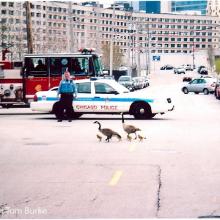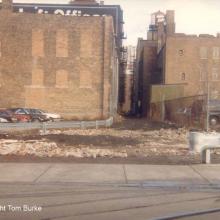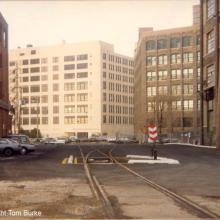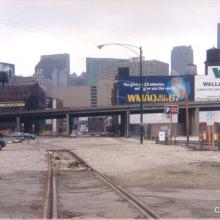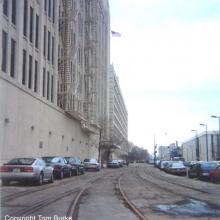861 Hits for February 2013
Albums (0) & Images (861)
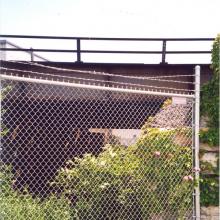
tb_deeringnorthline_0703_01
Another Deering Line artifact. This underpass below the Union Pacific's (C&NW) North Line was used by the Milwaukee Road's Deering Line to reach industries in the switching district. Note the cut-stone abutments. The best way to view this bridge is from the back of the shopping center off Clybourn by the river. There is no access from the other, east side, of this underpass.Unfortunately the rapid transformation of this area during the 1980s and 1990s from industrial to retail wiped out virtually every other trace of the Deering Line.
tb_deeringnorthline_0703_01
Unfortunately the rapid transformation of this area during the 1980s and 1990s from industrial to retail wiped out virtually every other trace of the Deering Line.
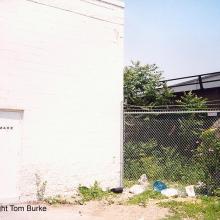
tb_deeringnorthline_0703_02
Looking east once again, behind the T.J. Maxx store gives a little more perspective to the underpass. At the time of this set of photos, the tracks were gone from underneath the bridge but there were still some ties scattered in the weeds and trash, past the chain-link fence.At one time, the Deering Line weaved northwest along the Chicago River past Diversey Blvd. To serve the massive Deering Works plant of International Harvester. Today the Lathrop public housing complex occupies this site.
tb_deeringnorthline_0703_02
At one time, the Deering Line weaved northwest along the Chicago River past Diversey Blvd. To serve the massive Deering Works plant of International Harvester. Today the Lathrop public housing complex occupies this site.
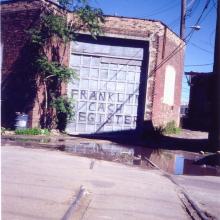
tb_deeringsmithwire_1991_01
Almost a decade after the Deering Line was abandoned in the early 1980s, an isolated spur track still ran into a building on Medill St. in Chicago near the intersection of Fullerton and Ashland Avenues. According to old Milwaukee Road engineering maps, this building once housed the Smith Wire & Iron Works. It must have been quite a sight to see back then, with either Milwaukee Road steam locomotives or a first generation diesel shoving a freight car through the entrance with the roll-top door. Note the girder rail in the street to protect against derailments. As of 2003, this scene is gone.tb_deeringsmithwire_1991_01

tb_deeringwebster_01
This view looks north from Webster and Dominick at one of the last pieces of Deering Line rails visible north of Finkl Steel. If you look closely to the left in the photo you can see one of the rails poking through the gravel. At one time the Milwaukee Road's Deering Line passed through a tire company lot to reach industries to the west. The 1995 Milwaukee Railroader article shows a picture of a train on Dominick near this location.tb_deeringwebster_01
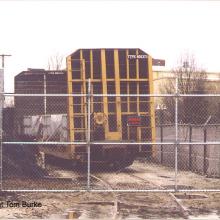
tb_finkl1_121104_01
On a cold, grey December 11, 2004, morning a bulkhead flatcar sits just inside the protective fences of the Finkl Steel complex by Kingsbury St. Several wooden crates are on the flatcar, perhaps some equipment being delivered for this steel plant. Behind the flatcar is a gondola. This track into Finkl at one time was part of the former Milwaukee Road Deering Line. The Beware of Dog sign is a new addition to the gate.tb_finkl1_121104_01
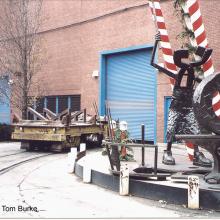
tb_finkl2_121104_02
It’s rare to see one of Finkl Steel’s intraplant rail cars out in the open. This picture was taken from the sidewalk along Cortland Ave. at Southport Ave. This section of Southport was vacated by the City of Chicago and given to Finkl for expansion of their plant in the 1990s. Finkl’s intraplant tracks and specialized rail equipment connect the various buildings and cross busy Cortland near the North Branch of the Chicago River. They are not used in interchange with standard railroad cars. Play it safe and only take pictures from settings like public streets and sidewalks.tb_finkl2_121104_02
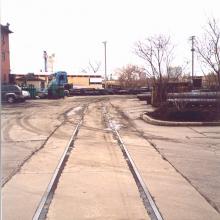
tb_finkl3_121104_03
This view looks south across Cortland Ave. and shows a stub segment of the Finkl Steel intraplant rail network. In the background is a Metra bilevel commuter coach awaiting scrapping by General Iron on Kingsbury. CP Rail is kept busy these days shuttling old Metra coaches from the UP interchange across the drawbridge over the Chicago River to the siding where the salvage operation takes place. Metra is replacing the old coaches with new models featuring larger windows. Gondolas carry out the remains of the scrapped coaches.tb_finkl3_121104_03

tb_flatcarsgooseisland_01
We're looking at the bankrupt Milwaukee Road's Division St. yard on Goose Island in 1985. In another year the Milwaukee Road itself will be history and Canadian Pacific subsidiary Soo Line will take over operations of most of the former Milwaukee Road lines, including on Goose Island. In its heydey, there were dozens of parallel tracks in this yard with a dedicated locomotive and freight station to keep up with the demands of the Goose Island industries. By 1985 it was a weedy shadow of its former self with many redundant tracks already pulled up.A line of gondolas in apparent scrap steel service are in the foreground, with a boxcar and bulkhead flatcar in the background. Today there are no traces of the yard, which outlived its usefulness when most of the rail-served industries left Goose Island. Instead the City of Chicago and CP Rail built a new line that runs down the middle of the reconstructed Cherry St. to reach Naz-Dar [edit: 10 Jan 2005. Naz-Dar does not receive rail shipments.] and Big Bay Lumber, the last two Goose Island rail customers. Concrete streets, neat curbs, and sidewalks replace the dirt surface of the Cherry St./Division St. area in this view. The yard area now houses various warehouses and commercial buildings.
An excellent view of the Goose Island Divison St. yard from April of 1970 with a transfer run with two GP9s can be found on page 22 of the book "The Milwaukee Road in Color: Volume 1, The East End." It's depressing to compare the two views.
tb_flatcarsgooseisland_01
A line of gondolas in apparent scrap steel service are in the foreground, with a boxcar and bulkhead flatcar in the background. Today there are no traces of the yard, which outlived its usefulness when most of the rail-served industries left Goose Island. Instead the City of Chicago and CP Rail built a new line that runs down the middle of the reconstructed Cherry St. to reach Naz-Dar [edit: 10 Jan 2005. Naz-Dar does not receive rail shipments.] and Big Bay Lumber, the last two Goose Island rail customers. Concrete streets, neat curbs, and sidewalks replace the dirt surface of the Cherry St./Division St. area in this view. The yard area now houses various warehouses and commercial buildings.
An excellent view of the Goose Island Divison St. yard from April of 1970 with a transfer run with two GP9s can be found on page 22 of the book "The Milwaukee Road in Color: Volume 1, The East End." It's depressing to compare the two views.
